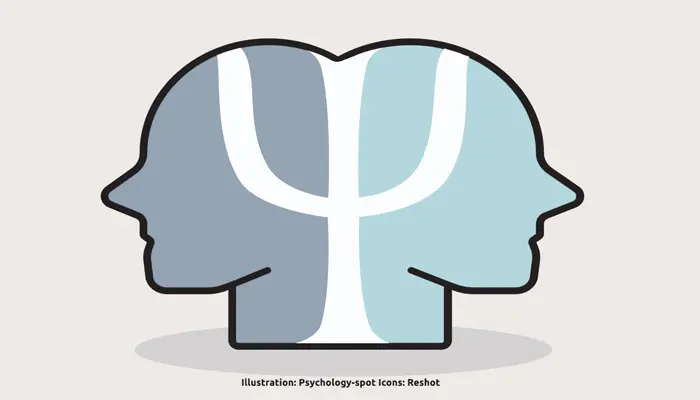
Displacement is a defense mechanism that we have all used at times. When we feel certain negative emotions or impulses, we do not always find the appropriate coping strategies, so we put in place mechanisms at the unconscious level that help us repress and hide that discomfort.
In fact, defense mechanisms such as displacement are a strategy of our unconscious to reduce the anxiety we experience, avoid possible trauma and restore our mental balance. These defenses operate below the radar of our consciousness to help us deal with internal and external factors that threaten us. However, the fact that we are not aware of their existence does not mean that they do not influence our behaviors and decisions.
What is displacement in Psychology?
The concept of displacement as a defense mechanism originated in Sigmund Freud’s theory of dream formation. Freud thought that displacement was a dream distortion mechanism through which unconscious content is transformed into manifest content.
Today, the definition of displacement in psychology has changed and refers to a defense mechanism in which a person redirects a negative emotion from its original source to a less threatening receptor. By expelling the original stress from consciousness, anxiety is reduced, but it is likely that in the long term the coping will not be adaptive, since the source of the conflict generally remains latent.
There are many examples of displacement in Psychology, some quite common. In fact, it is common for us to shift anger or frustration to other people who are not the ones who generated it. For example, if we have had a problem with our boss, but we think it would be unwise to vent our anger on him because it could cost us our job, we can suppress it until the end of the day. However, when we get home, the slightest slip from our partner or children will cause us to overreact, pouring out that contained anger on them.
However, displacement does not only occur at the interpersonal level but also at the group or social level. A relatively common example of displacement in these times, consists of projecting the frustration of having lost a job on certain groups that we consider guilty, such as immigrants.
Those groups, who represent less of a risk to us, become the scapegoat who bears all the blame while we make them the targets of our anger, insecurities and fears. All to avoid having to face a reality that is too threatening to us and for which we do not have the necessary coping mechanisms.
How does the displacement mechanism work?
We resort to displacement when we believe that reacting to the original source of our frustration might be unacceptable or even dangerous. Instead, we look for a person, activity, or situation that is less threatening to us and that can serve as a more secure outlet for our negative feelings.
In fact, a study carried out at Chungnam National University found that states of physical and emotional arousal tend to shift from one situation to another, they do not disappear as easily as we think. Therefore, if we consider that a reaction is inappropriate in a certain situation, we can repress those feelings, but they will not disappear, we would release them later in a situation that we consider more favorable where their consequences are less dangerous.
The displacement mechanism therefore fulfills a double function. On the one hand, it allows us to channel the emotions and impulses that we consider inappropriate or harmful in a safer way – at least in the short term. On the other hand, it keeps the stress out of our consciousness, preventing us from having to face a situation for which we do not have the adequate psychological resources.
In fact, if used in a timely manner, displacement can be a useful defense mechanism to protect us from negative feelings and harmful impulses. It can help us minimize disappointment, reduce stress, protect us from anxiety, and shield our ego. Researchers from Harvard University even found that the adaptive use of defense mechanisms such as displacement is related to better physical health and more satisfactory interpersonal relationships.
Freud himself believed that sublimation, which is a type of displacement, can become an important source of creativity and inspiration. In practice, it would help us shift emotions and impulses towards socially accepted activities, such as art. Thus sublimation would be a constructive outlet for unacceptable or dangerous impulses.
However, displacement can also have a dark side, especially if we make it a common strategy.
The darker side of displacing emotions and impulses
Displacement can cause a chain reaction. Displaced aggression, for example, can become a cycle as we do not face the source of the conflict. If we have problems with our boss and we do not solve them, but we constantly divert that anger towards our family, for example, family relationships will end up suffering. When we do not face the source of the conflict, it remains latent, generating a great psychological tension that will end up taking its toll in one way or another.
In fact, a study conducted at the University of West Scotland revealed that the use of immature defense mechanisms is associated with a greater propensity to develop an addiction to food or alcohol, which is probably due to the fact that these become the escape route for that psychological tension.
Likewise, displacement at the social level is usually a source of prejudice and stereotypes towards certain groups and in some cases they can even have a violent exit. A terrible example of displacement in history is found in the Nazi Holocaust. The Jews became the target of the frustrations and anger of the German people over the economic consequences of the First World War. Instead of directing their collective anger at their own government or seeking a mutually satisfactory solution, they redirected it toward a more vulnerable group of people.
How to deal with displacement assertively?
• Look for more assertive outlets for your emotions. The displacement of emotions does not always have to occur towards another person or group. Sublimation, for example, is a cathartic outlet for those impulses. Therefore, try to use that energy to create something positive with which you can connect with the others. You can find that outlet in painting, sculpture, writing, or even doing physical activity.
• Resolves the latent conflict. It is not always easy, but it is essential. A study carried out at the University of Kansas found that blood pressure drops more when we discharge our anger directly on the person who has caused it than when we move it towards substitute objects. That means that at some point we have to deal with the source of that psychological tension.
Therefore, if we discover that we are using displacement, we must work to develop conscious coping strategies that allow us to deal with the problem at the base. If we do not do it, it is likely that we will continue to drag that psychological tension and that we will shift it to others as soon as we have the opportunity.
Sources:
Sohn, J. et. Al. (2015) Effect of emotional arousal on inter-temporal decision-making: an fMRI study. Journal of Physiological Anthropology; 34: 8.
Malone, J. C. et. Al. (2013) Adaptive midlife defense mechanisms and late-life health. Personality and Individual Differences; 55(2): 85-89.
Mohiyeddini, C. et. Al. (2013) Displacement Behaviour Is Associated with Reduced Stress Levels among Men but Not Women. PLoS One; 8(2): e56355.
Costa, R. M. & Brody, S. (2013) Immature psychological defense mechanisms are associated with greater personal importance of junk food, alcohol, and television. Psychiatry Res; 209(3): 535-539.
Hokanson, J. E., Burgess, M. & Cohen, M. F. (1963) Effect of displaced aggression on systolic blood pressure. The Journal of Abnormal and Social Psychology; 67(3): 214–218.



